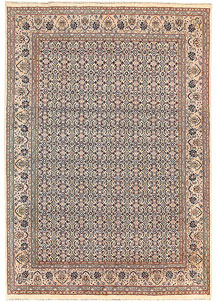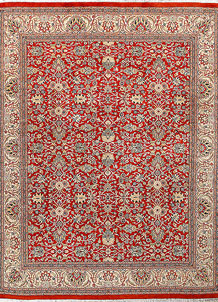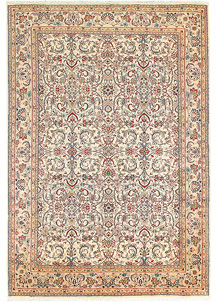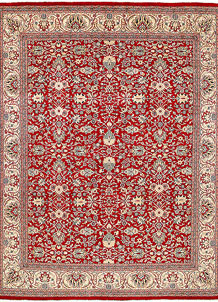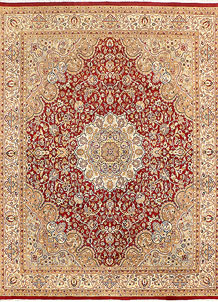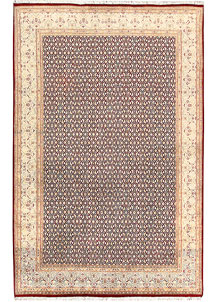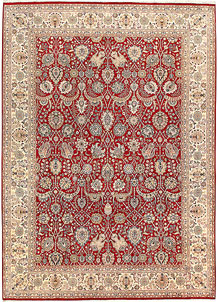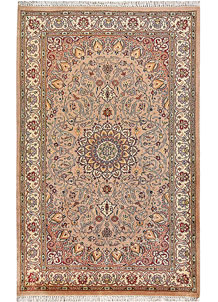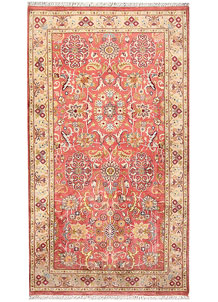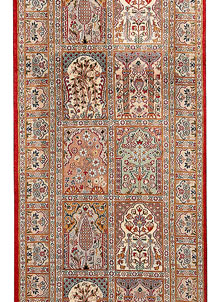Afghan Rugs
Afghan rugs (also known as Afghani rugs, Afghanistan rugs or Afgan rugs) are handmade carpets that originate from Afghanistan, a country with a long history of rug weaving dating back to ancient times. These rugs are renowned for their quality, beauty, and cultural significance, and are highly valued by collectors and interior designers around the world. Traditionally, Afghan rugs are made using high-quality wool, which is sourced from local sheep, and are hand-knotted using traditional weaving techniques. Each rug can take several months or even years to complete, as the process involves carefully tying each knot of the carpet by hand. The resulting carpets are highly durable and can last for decades or even generations with proper care. One of the distinguishing features of Afghan rugs is their bold designs and vibrant colors, which often include intricate geometric patterns and motifs inspired by traditional Afghan art and culture. Many Afghan rugs also feature unique design elements such as animal and human figures, floral patterns, and calligraphy.
Rugs By Category: Afghan
95 results. Displaying 85 to 168.
History of Afghan Rugs
The history of Afghan rugs can be traced back to ancient times, with evidence of rug weaving in Afghanistan dating back thousands of years. The art of rug weaving has played a significant role in Afghan culture and society, with handmade carpets serving both functional and decorative purposes.
In the early years of Afghan rug weaving, the nomadic tribes of Afghanistan would use locally sourced wool and natural dyes to create rugs for their own use. These early rugs were often simple in design, featuring geometric shapes and bold colors.
Over time, as rug weaving became more established in Afghanistan, weavers began to develop more intricate designs and patterns. Afghan rugs began to incorporate elements of Islamic art, such as calligraphy and intricate geometric designs, as well as designs inspired by nature, including flowers, animals, and trees.
During the 19th century, Afghanistan became an important center for rug weaving, with many workshops and schools established in cities such as Herat and Kabul. The production of handmade rugs became an important source of income for many Afghans, and rugs were often traded and sold in local bazaars and markets.
Today, the rug weaving industry in Afghanistan continues to thrive, although it has faced challenges in recent years due to political turmoil and conflict. Many weavers continue to produce high-quality, handmade rugs using traditional techniques and designs, and the beauty and cultural significance of Afghan rugs continue to be celebrated around the world.
Types of Afghan Rugs
There are several types of Afghan rugs, each with its own unique style, design, and history. Here are a few examples:
- Baluchi rugs: Baluchi rugs are made by the Baluchi tribes of Afghanistan and Pakistan. These rugs are known for their bold, geometric designs and rich, dark colors.
- Khal Mohammadi rugs: Khal Mohammadi rugs are named after the village of Khal Mohammadi in northern Afghanistan, where they are traditionally made. These rugs are characterized by their deep, rich red color and often feature intricate floral and vine motifs.
- Turkmen rugs: Turkmen rugs are made by the Turkmen tribes of Afghanistan and Turkmenistan. These rugs are known for their intricate designs and vivid, saturated colors, often featuring repeating patterns and tribal symbols.
- Afghan war rugs: Afghan war rugs are a unique type of rug that emerged during the Soviet-Afghan War in the 1980s. These rugs feature images of war, including tanks, guns, and helicopters, as well as depictions of everyday life in Afghanistan.
- Maimana rugs: Maimana rugs are made in the city of Maimana in northern Afghanistan. These rugs are known for their high-quality wool and intricate designs, often featuring floral patterns and geometric motifs.
- Herati rugs: Herati rugs are made in the city of Herat in western Afghanistan. These rugs are known for their intricate patterns and colors, often featuring a central medallion surrounded by floral and geometric designs.
These are just a few examples of the many types of Afghan rugs, each with its own unique style and history.
In addition to the traditional types of Afghan rugs, there are also more modern types of Afghan rugs that have emerged in recent years. These rugs often blend traditional Afghan rug-making techniques with contemporary design sensibilities, resulting in rugs that are both beautiful and unique. Here are a few examples:
- Gabbeh rugs: Gabbeh rugs are a modern style of Afghan rug that emerged in the 20th century. These rugs are characterized by their thick pile and simple, abstract designs. They are often made using natural dyes and high-quality wool.
- Ziegler rugs: Ziegler rugs are a type of Afghan rug that was developed in the late 19th century. They were designed to appeal to Western tastes, and feature more muted colors and simpler designs than traditional Afghan rugs. Today, Ziegler rugs are still popular and are often used in contemporary home decor.
- Contemporary tribal rugs: Many Afghan rug weavers are continuing to innovate and experiment with new styles and designs. Contemporary tribal rugs often blend traditional motifs with more modern design elements, resulting in rugs that are both timeless and of-the-moment.
- Shindand rugs: Shindand rugs are a modern type of Afghan rug that are made in the Shindand district of western Afghanistan. These rugs are characterized by their bright, bold colors and geometric designs.
Overall, the modern types of Afghan rugs reflect the creativity and innovation of Afghan rug weavers, and show how this ancient art form continues to evolve and adapt to changing times.
Major carpet weaving centers in Afghanistan
Afghanistan has several major centers of rug weaving, each with its own unique style and history. Here are a few examples:
- Herat: Herat is a city in western Afghanistan that has a long history of rug weaving. Herati rugs are known for their intricate designs and rich colors.
- Mazar-i-Sharif: Mazar-i-Sharif is a city in northern Afghanistan that is famous for its Maimana rugs. These rugs are known for their high-quality wool and intricate designs, often featuring floral patterns and geometric motifs.
- Kunduz: Kunduz is a city in northeastern Afghanistan that is known for its Turkmen rugs. These rugs are characterized by their intricate designs and vivid, saturated colors, often featuring repeating patterns and tribal symbols.
- Kabul: Kabul is the capital of Afghanistan and is home to many rug dealers and weavers. The rugs produced in Kabul vary widely in style and quality, and include everything from traditional tribal rugs to more modern and contemporary styles.
- Kandahar: Kandahar is a city in southern Afghanistan that has a long history of rug weaving. Kandahari rugs are known for their bold designs and bright colors, often featuring intricate floral and geometric motifs.
These are just a few examples of the many centers of rug weaving in Afghanistan. Each region has its own unique history and style, and the rugs produced in these areas are highly prized for their quality and beauty.
Frequently Asked Questions
Q. How are Afghan rugs made?
Afghan rugs are made using traditional hand-knotting techniques that have been passed down for generations. Here's a general overview of the rug-making process:
- Wool preparation: The first step in making an Afghan rug is to prepare the wool. Wool is sourced from local sheep and goats, and is washed, carded, and spun by hand to create the yarn that will be used to make the rug.
- Design: Once the wool is prepared, the rug weaver will create a design for the rug. This can be a traditional tribal design or a more modern pattern, depending on the weaver's preference.
- Warp and weft: The next step is to set up the loom, which consists of a frame with vertical threads (the warp) and horizontal threads (the weft). The weaver will then tie the yarn to the warp threads, creating the foundation for the rug.
- Knotting: With the warp and weft in place, the weaver will begin knotting the yarn around the warp threads to create the pile of the rug. This is a slow and meticulous process, with each knot carefully tied by hand.
- Trimming: Once the rug is complete, the weaver will trim the pile to create an even surface. This is done using a special tool called a shears.
- Washing: After the rug is trimmed, it is washed to remove any dirt or debris that may have accumulated during the weaving process.
- Finishing: Finally, the rug is finished by adding fringes or a border around the edges.
The process of making an Afghan rug is highly skilled and time-consuming, with each rug taking weeks or even months to complete. The result is a beautiful and durable rug that is highly valued for its quality and craftsmanship.
Q. How to buy an Afghan rug?
If you are interested in buying an Afghan rug, here are some general tips to help you make a good purchase:
- Research: Before you start shopping, do some research on Afghan rugs. Learn about the different styles, materials, and quality factors that can affect the price of a rug. This will help you make an informed decision and avoid overpaying. You can look at the Afghan rugs listed above and learn more about them by going to their rug page.
- Choose a reputable online seller: Look for a reputable online seller who specializes in Afghan rugs. Check reviews and ratings online, and ask for recommendations from friends or family members who have purchased rugs in the past. Qaleen specializes in Afghan rugs and is one of the major sellers of handmade rugs from Afghanistan.
- Ask about the materials: Ask about the materials used to make the rug. Afghan rugs are typically made from wool, but some may also include silk or other fibers. Higher-quality rugs are typically made from natural, hand-spun wool. You can always inquiry from Qaleen team if you have any questions about any Afghan rug on our website.
- Consider shipping and customs fees: If you are purchasing the rug from abroad, be aware that there may be additional shipping and customs fees. Make sure to factor these into the total cost of the rug. Qaleen delivers you any handmade rug from our website with FREE shipping and absolutely no custom to your home in the US.
- Care for your rug: Once you have purchased your Afghan rug, take care to maintain it properly. Follow the care instructions provided by the dealer, and consider having it professionally cleaned every few years to keep it looking its best.
Overall, buying an Afghan rug can be a rewarding experience if you take the time to do your research and find a reputable dealer. With proper care, an Afghan rug can be a beautiful and lasting addition to your home.
Q. How to clean an Aghan rug?
Cleaning an Afghan rug requires some care to avoid damaging the delicate fibers and dyes. Here are some general tips for cleaning an Afghan rug:
- Vacuum regularly: Vacuum your rug regularly to remove loose dirt and dust. Use a vacuum with a low-power setting or a handheld attachment to avoid damaging the fibers.
- Spot-clean stains: If you notice a stain on your rug, spot-clean it immediately with a clean cloth and a mild detergent. Blot the stain gently, taking care not to rub it in further.
- Avoid water: Avoid getting your rug wet, as this can damage the fibers and cause the colors to bleed. If you need to clean a larger area, consider having it professionally cleaned by a rug cleaning specialist.
- Professional cleaning: Professional cleaning is recommended every few years to keep your rug looking its best. Look for a cleaning specialist who has experience with Afghan rugs and uses gentle, non-toxic cleaning methods.
- Sunlight exposure: Avoid exposing your Afghan rug to direct sunlight for prolonged periods, as this can cause the colors to fade. If possible, rotate the rug periodically to avoid uneven fading.
- Avoid harsh chemicals: Avoid using harsh chemicals or bleach on your rug, as this can damage the fibers and cause the colors to fade.
Overall, cleaning an Afghan rug requires some care and attention to ensure that it remains in good condition. With proper maintenance and occasional professional cleaning, your rug can be a beautiful and lasting addition to your home.
Q. Are Afghan rugs a good investment?
Afghan rugs can be a good investment if you choose carefully and take proper care of your rug. Like any investment, the value of an Afghan rug can vary depending on factors such as its age, rarity, quality, and condition.
Older and rarer Afghan rugs, particularly those made by skilled artisans, can be quite valuable and can appreciate in value over time. However, it's important to note that the value of a rug can also be affected by market trends, changes in taste, and other factors outside of your control.
To make a good investment in an Afghan rug, it's important to do your research and choose a rug that is well-made, high-quality, and in good condition. Look for rugs that have even knots, a tight weave, and vibrant colors that are made from natural, hand-spun wool.
It's also important to take proper care of your rug to help preserve its value over time. This includes regular cleaning, proper storage, and avoiding exposure to sunlight and moisture.
Overall, investing in an Afghan rug can be a good way to add beauty and value to your home, but it's important to approach it as a long-term investment and take proper care to ensure its longevity and value over time.




